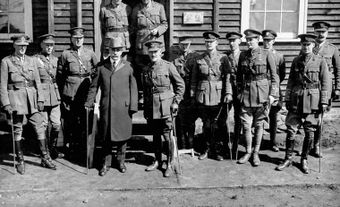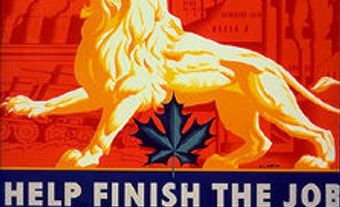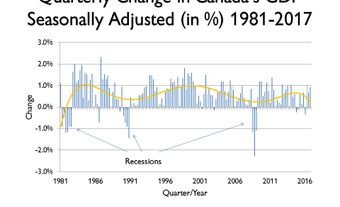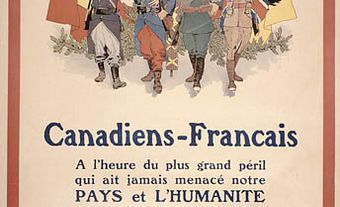Federal income tax was initiated in Canada in 1917 to help finance the First World War. The struggling economy and a political crisis resulting from conscription triggered its need. In the first years, income tax was imposed on a minute share of the population, but today, almost 80 per cent of Canada’s population files tax returns.
First World War Debt
When Great Britain declared war on Germany in 1914, Canada was in an economic recession, and the federal government was spending beyond its means. The past few decades were costly for the country due to the construction of transcontinental railways and settlement of the Prairies. (See also Railway History in Canada.) By 1913, the net debt was $314.3 million, a giant leap from $75.7 million in 1867. It was inevitable that Canada’s debt would grow significantly larger once war started.

To finance the deficit, the federal government borrowed from the British government, but when funds were exhausted, they turned to the United States (see also First World War (WW1)). Next, the government called on everyday Canadians to do their part. Beginning in 1915, Victory Bonds were sold to citizens, corporations and various types of organizations (see also Victory Loans; Bonds in Canada). The advantage for the purchaser was that the bond could be exchanged after 5, 10 or 20 years, for the same value with interest.
Honourable Sir William Thomas White

The government’s immense borrowing was not enough and a new plan unveiled in 1917 by the Honourable William Thomas White would become a milestone in Canada’s tax history (see Taxation in Canada). Born in Bronte, Ontario (see also Oakville) in 1866, White was a reporter for Toronto’s The Evening Telegram and was later manager of the National Trust Company. With experience as a tax assessor and financier, White was appointed Minister of Finance by Prime Minister Sir Robert Borden in 1911. That year, White also became the new MP of Leeds County.
Did you know?
Sir William Thomas White served as Acting Prime Minister from 20 February 1919 to 23 May 1919, when Prime Minister Borden was in Europe.
By 1915, Canada’s financial problems spiralled downwards and the net debt was $449 million. Around the same time, White was knighted. According to the 1 January 1916 Montreal Gazette, he was awarded this distinguished honour, in part, for “…handling finances of the Dominion with such marked success during an extremely critical period…” However, any celebration White may have had was clouded by his extensive borrowing that finally led to inflation (see First World War (WW1).
Reluctantly, White presented the Business Profits War Tax Act in Parliament, which became law in May 1916 (see also Sir Robert Borden). This new law aimed at stopping businesses from making a high profit during an emergency. Businesses that made profits of over seven per cent were subject to an ascending tax rate and were required to file a yearly tax return.
“The Conscription of Wealth”

White was hesitant to impose income tax, partly because he believed that it would be challenging to administer in a vast country with few staff. But the death toll was mounting and, by 1917, the First World War was already the deadliest war in Canadian history. When voluntary recruitment had slowed down, Prime Minister Borden pushed forth the controversial Military Service Act. Enacted on 29 August 1917, the Act made it mandatory for all male citizens aged 20 to 45 to be available for military service through the end of the war (see also Conscription in Canada) .

Conscription changed public opinion. With thousands of men dying on the battlefield, Canadians and the government demanded that Canada’s rich do their part. A phrase arose on streets, in homes and in newspapers – “the conscription of wealth.” Many felt that the wealthy population was morally responsible for contributing financially.
Income War Tax Act
By the summer of 1917, there was a political crisis in Parliament that arose from the imposition of conscription. Following lengthy debates in the government and mounting public pressure, White proposed the Income War Tax Act, which received royal assent on 20 September 1917. The Act was the first direct federal tax on income, and it was a new source of federal revenue. Prior to the war, more than 85 per cent of federal revenue was composed of taxes on goods transported across the border, as well as postal rates and tariffs on imported goods. The new income tax also threatened Canada’s position as one of the lowest taxed countries worldwide.
The Income War Tax Act was intended to first finance about 100,000 military personnel needed to continue the war effort overseas. It imposed a four per cent tax over the personal exemption of $1,500 on the income of widows, unmarried people and widows without dependent children. Others had a tax exemption of $3,000. In the first years that the tax was administered, approximately 2 to 8 per cent of Canada’s population completed tax returns, a direct reflection of its high dollar exemptions.
When war ended in 1918, approximately $8 million had been collected, a minute fraction of the overall cost of the war.
After the war
Despite what many hoped was temporary, personal income tax was here to stay. The staggering financial burden of the war had resulted in a national net debt of $1.6 billion in 1919, a figure five times higher than in 1914. During the Second World War, income tax expanded dramatically and, after many years of being considered permanent, the Income Tax Act came into effect on 1 January 1949 after the Income War Tax Act was redrafted. Today, approximately one half of the federal government’s revenue is derived from personal income tax, a significant increase from 2.6 per cent in 1918.
In 1938, 2.3 per cent of Canada’s population filed tax returns. That figure dramatically increased over the years, and today it sits at almost 80 per cent.

 Share on Facebook
Share on Facebook Share on X
Share on X Share by Email
Share by Email Share on Google Classroom
Share on Google Classroom








